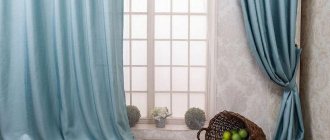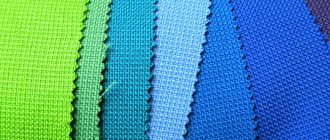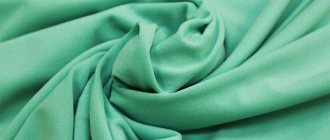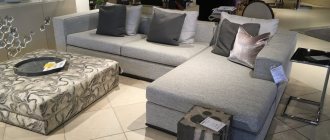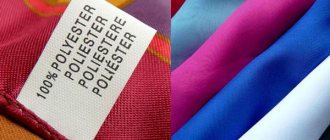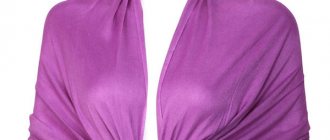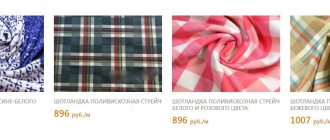general description
Polycotton began to be produced in the 20th century (late 50s). It is one of the most common mixed fabrics for sewing bedding. For example, about 80% of all hotels in the world use bedding sets made from this material.
Polyester and cotton are mixed in different proportions depending on the purpose of the fabric. Most often, the threads are woven using a simple plain weave. Externally, the fabric resembles calico. Polycotton is used to make bed linen, covers for furniture and bedding, home textiles, slings, and clothing.
Comparative characteristics of cotton varieties: memory and stretch
The educational story tells about the benefits of cotton and compares in detail two types of material: stretch cotton and memory cotton. The video contains useful tips and helps you choose the most suitable products for sewing.
See similar articles
- Satin - silk fabric with a thousand-year history
- Jersey is a versatile and unpretentious fabric
- Crepe georgette is a translucent fabric with a grainy texture.
- Jeans - fashionable thick cotton fabric
- Diving - close-fitting viscose fabric
- Crepe is a light and durable rough textured fabric.
If you liked the article, share it with your friends!
Fabric structure
The production of polycotton made it possible to almost completely get rid of the disadvantages inherent in fibers in their pure form. Cotton in its pure form has the following disadvantages:
- strong creasing;
- rapid loss of color;
- shrinkage;
- loss of shape even after short use.
Polyester has the following negative qualities:
- poor air conductivity;
- rigidity;
- electrification;
- poor colorability.
If polyester is heavily predominant in the composition of polycotton, the manifestation of its negative properties increases. If there are more natural raw materials, then the fabric is like cotton. It is best if the proportions of the fibers are approximately equal. The optimal ratio for bed linen is: 50% polyester and 50% cotton or 35% polyester and 65% cotton .
The quality, appearance and beneficial properties of polycotton depend on the percentage of fibers. The most common fiber combinations:
- 15% cotton and 85% polyester;
- 35% cotton and 65% polyester;
- 50% cotton and 50% polyester;
- 65% cotton and 35% polyester.
Related article: DIY bead pendant: master class with video
Which is better for sheets: cotton or polyester?
When you hear the term polyester, the first thing that probably comes to mind is an uncomfortable and awkward stretchy garment. But polyester as a fabric has come a long way from the clothing of the 80s. Polyester fabric is branched into household items such as bedding, curtains and even sheets! Polyester sheets are steadily gaining popularity due to their comfort, ease of maintenance and durability.
The best-selling bedding fabric is cotton, and it has been that way for generations! Cotton is smooth, fresh, naturally breathable and repels moisture in every thread, making them durable for years to come. So, if you are looking for bed sheets for this summer, then you can buy bed sheets online where you can get new collections of pure cotton bed sheets that match your room decor at the most affordable prices.
Cotton can be recycled and reused in many ways, but what about polyester? Can it stand up to the reputation of cotton sheets? Let's compare both and find out!
Cotton sheets
Cotton sheets are designed keeping the sleeper's comfort in mind. These sheets should provide a crisp yet smooth feel without any obstructions in the material or annoying sleep impacts. Cotton sheets should fit smoothly against your mattress to create an expanse of fabric that not only protects your mattress from tears or stains, but also protects your skin from unwanted moisture that can harbor bacteria.
Advantages and disadvantages
- Textile
Cotton sheets are made using multiple threads of cotton that are woven together to create a large piece of fabric. High-quality cotton sheets, commonly known as Egyptian cotton, are made using long fibers rather than the short ones typically found in cotton sheets, and will have a softer, silkier feel with each higher thread count level. For example, a 300 thread count cotton sheet set will feel smooth on the skin, but not as soft as a 1000 thread count set.
- Durability
Cotton sheets have a long service life even with daily use. The durability of cotton fibers has led to them being used in everything from curtains to clothing, bags to sheets. People have reported using the same sheets for up to 10 years!
- Color
Cotton sheets may fade over time, but that doesn't mean they're ready for the trash. Many people find second uses for cotton sheets in other ways, from children's toy chests to beach or picnic blankets. Others may cut sheets into strips for cleaning rags or use the whole sheet as a dyeing fabric.
- Breathable and moisture wicking
Cotton is one of the most breathable fabrics available on the market today, appealing to consumers during the warmer months or those living in hot, humid climates. If you suffer from night sweats, cotton sheets will help you sleep comfortably. The natural breathability of cotton sheets allows your body heat to release into the atmosphere of your bedroom, rather than lingering on the covers and raising your body temperature.
- Wash
Cotton sheets can be washed in the washing machine normally, using the same water temperature as other clothes. White or light-colored fabrics wash best at higher temperatures, while cold water prevents the colors of dark fabrics from fading.
Polyester
Polyester sheets should be soft against the skin, but it's important to keep in mind that they won't command as much of a price tag as cotton, which is because they're made from a man-made fiber.
Advantages and disadvantages
- Textile
Polyester, as mentioned earlier, is a man-made material that is spun together using a combination of machines and binders. This style of material may be unappealing to some, especially those who only want to use organic materials in their daily lives.
- Durability
Polyester sheets have durability that can almost match that of cotton sheets, and the strength of this fabric depends on the materials from which it is made. Polyester shares some of the same substances as plastic, so it won't tear easily from daily use and can be reused in other ways after it has lost its usefulness as sheets.
- Breathability
Polyester isn't known as a breathable fabric, but manufacturers have sought to change that perception by using a simple weave pattern that allows air to circulate. This sheet option will help those who live in humid climates by allowing moisture to evaporate from the fabric into the atmosphere.
Polyester also doesn't absorb moisture at the same level as cotton, but it does have super-fast drying ability.
Conclusion
Cotton and polyester sheets have their advantages and disadvantages, but it really depends on your personal preference. What may be an advantage or benefit to you and your family may be what keeps another consumer from purchasing the same style of sheets.
Fabric properties
Positive characteristics of polycotton:
- Wear resistance. Frequent washing and long-term use do not affect the quality and appearance of items made from this fabric. The color retains its brightness.
- No fiber migration. Threads and fibers do not come out of the warp and do not move.
- Wrinkle resistance. The fabric does not require ironing after washing and does not wrinkle during use.
- Practicality in operation. The fabric is machine washable, and heavy stains can be removed with less than normal amounts of powder. The material dries quickly and does not absorb dirt.
- Relatively low cost.
- Minimal deformation and shrinkage. Polycotton holds its shape and does not shrink. It is easy to cut and sew.
- Good hygroscopicity and breathability.
- Excellent tensile strength.
- The fabric is attractive in appearance.
If the polyester content of the fabric is more than 75%, polycotton acquires the following disadvantages:
- Poor air conductivity.
- Electrification.
- Weak resistance to friction. Very soon, hooks and pellets appear on the front surface.
It is better to choose high-quality polycotton, in which polyester is no more than 50%. In this case, the fabric will be without such shortcomings. However, for sewing covers, material with a higher content of polyester fibers is suitable.
Polyester: pros and cons
Polyester has many advantages. However, there are also certain disadvantages due to the fact that this fabric is still synthetic and not natural. The main advantages of the material are as follows:
- Clothes made from this fabric are practically wrinkle-free and do not require ironing;
- The material is very resistant to dirt and external influences;
- Any dirt can be easily washed off the surface of the fabric without long, tedious washing;
- You can wash things made of polyester either by hand or in a washing machine;
- The fabric contains cotton fibers, so clothing made from fabric allows air to pass through well and allows the skin to breathe;
- Products made from polyester look impressive, they are very beautiful and elegant. Clothes made of polyester can be worn both on holiday and at work, on vacation, on a country walk or on a trip.
However, this fabric also has several disadvantages , although polyester has objectively more advantages. A significant disadvantage of this material is its increased density. On the one hand, increased density is a plus, because increased density means resistance to pollution and external influences.
But, on the other hand, in summer and spring , when it is hot outside, the increased density of the fabric from which a person’s clothing is made can lead to overheating and disruption of thermoregulation. Therefore, clothes made of polyester, especially black and other dark colors and shades, are not recommended to be worn in extreme heat. If this rule is neglected, natural thermoregulation mechanisms may be disrupted, which can provoke heat stroke.
Rules of care
To preserve all the qualities of polycotton, it is better to adhere to the following rules:
- Before use, lightly wash the item by hand in cool water.
- Wash items inside out; buttons and zippers must be fastened.
- The washing temperature should not exceed 40 °C.
- Use minimal bleach. It is prohibited to use products containing chlorine.
- To get rid of static electricity, you can use fabric softener with an antistatic effect.
- The fabric should be ironed at a low temperature.
- After washing, straighten and dry vertically. Drying outdoors with protection from direct sunlight is advisable.
Polyester. Description and characteristics
Polyester is a synthetic fiber obtained from petroleum (polyester fibers) through careful processing. This is done like this: the raw material is heated to a certain temperature, passed through thin holes, the resulting fiber cools down - the synthetic thread is ready. Its use has gained popularity due to its high strength.
Fabrics last longer and do not require ironing, but if there is a need to iron, do it with a heated iron, choosing the “minimum” or “silk” mode. When you decide to iron a tracksuit, look at the ingredients on the tag. Almost always, there is synthetic fiber present - which means that an iron that is too hot will melt the material. This is a reaction to high temperature.
After washing, polyester items do not shrink or stretch . The color does not wash off, like with natural fabric. In addition, a thing made from this fiber does not fade, does not absorb moisture and dries quickly. It seems there are only advantages.
Now let's see if there is anything in common between plant fiber and artificial fiber.
